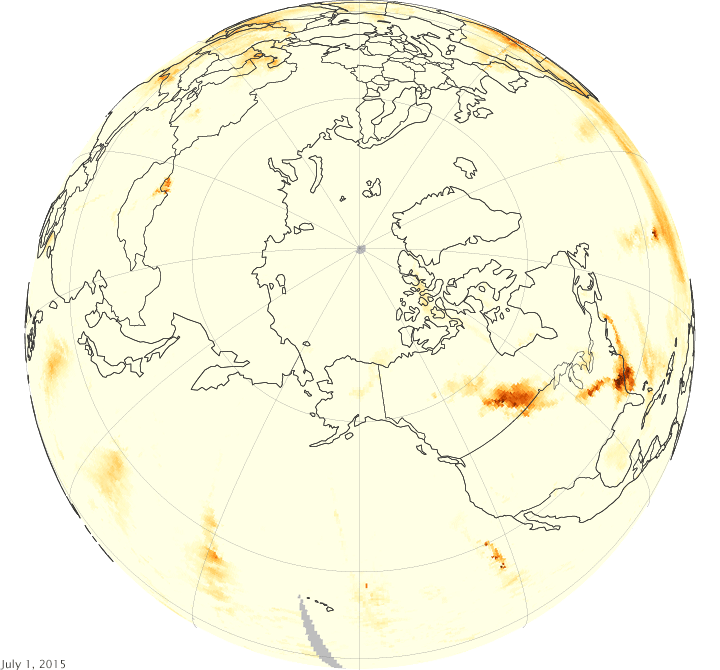


Vast patches of land have burned across Alaska and Canada in the 2015 fire season. But the area burned is only part of the story; smoke from these fires crosses political borders and even oceans. Wildfire smoke is a combination of gases and aerosols—tiny solid and liquid particles suspended in air—and can have an effect on cloud formation, atmospheric cooling and heating, and human health.
The animated series of images above shows the progression of smoke plumes from July 1 through July 14, 2015, around much of the Northern Hemisphere. The animation above was made from data collected by the Ozone Mapping Profiler Suite (OMPS) on the Suomi NPP satellite. It shows relative aerosol concentrations, with lower concentrations in yellow and higher concentrations in dark orange-brown. Gray areas show where data were unavailable.
At the start of the series on July 1, Alaskan fires sent a massive plume of smoke westward. By July 6, that same plume was continuing west over the Russian Arctic. Meanwhile, smoke from fires in Canada moved eastward across North America. Both plumes ultimately reached Greenland after wafting in opposite directions.
“Summertime wildfires in Alaska and Canada occur every year, with some inter-annual variations,” said Hiren Jethva, an atmospheric scientist at NASA’s Goddard Space Flight Center. But the distance traveled by the smoke varies greatly. Aerosol concentration and height, as well as wind patterns and speed, are just some of the factors that determine the course of a plume’s atmospheric journey.
Jethva and colleagues first used the Ozone Monitoring Instrument (OMI) on NASA’s Aura satellite to observe the long-range transport of the July 2015 plumes. Jethva noted that the plumes were often located over lower-level clouds for much of the period shown above. Researchers have found that when aerosols are located over clouds, or any other bright surface, they can impart a net warming effect on the climate. That, in turn, can affect the stability of the atmosphere and the lifetime of clouds.
“For the present event, all of these physical processes would likely influence the radiation balance over the Arctic region,” Jethva said, “which is experiencing climate change at a faster rate than any other region of the globe.”
NASA Earth Observatory image by Jesse Allen, using Suomi NPP OMPS data provided courtesy of Colin Seftor (SSAI). Suomi NPP is the result of a partnership between NASA, NOAA and the Department of Defense. Caption by Kathryn Hansen.